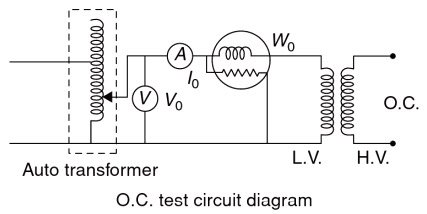During the open circuit test of a transformer
Right Answer is:
Primary is supplied rated voltage
SOLUTION
During the open circuit test of a transformer primary is supplied rated voltage.
Open-circuit test
The open-circuit test is used to measure core losses and obtain the core loss resistance and magnetizing inductance which is helpful in finding shunt branch parameters of the equivalent circuit.
The current drawn by shunt parameters in a transformer is a no-load current. Therefore the current that will flow in the circuit in the open circuit test is very low so the measurement of the quantities voltage, current, and power must be on the low voltage side so that the corresponding value will be readable in the instruments. And therefore, the open circuit test must be performed on the low voltage side. This means the high voltage side must be kept open. The current drawn from the open circuit test is the no-load current at a low power factor corresponding to the core loss component.
As the normal rated voltage is applied to the primary, therefore, normal iron losses will occur in the transformer core. Hence wattmeter will record the iron losses and small copper loss in the primary. Since the no-load current is very small (usually 2 — 10% of rated current), Cu losses in the primary under no-load conditions are negligible as compared with iron losses. Hence, wattmeter reading practically gives the iron losses in the transformer It is reminded that iron losses are the same at all loads.

